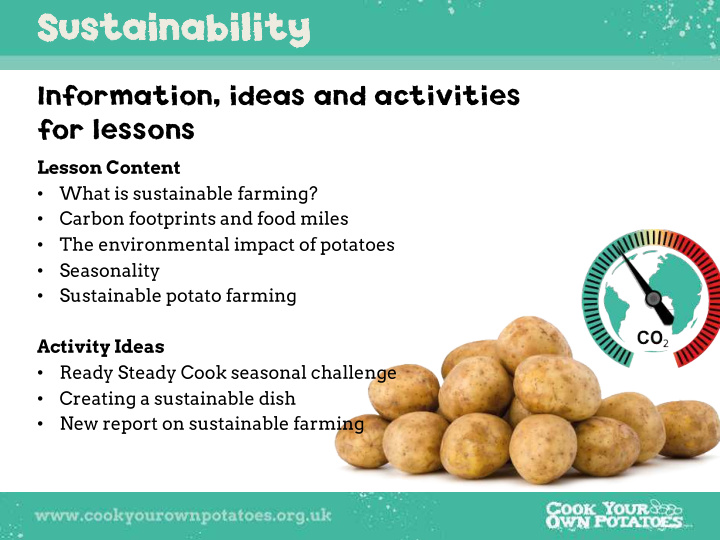



Sus Sustainability ainability Information, ideas and activities for lessons Lesson Content • What is sustainable farming? • Carbon footprints and food miles • The environmental impact of potatoes • Seasonality • Sustainable potato farming Activity Ideas • Ready Steady Cook seasonal challenge • Creating a sustainable dish • New report on sustainable farming
Sustainability Sus ainability Sus Sustainable ainable Farming Farming The production of crops using farming techniques that protect the environment, public health, human communities and animal welfare
Sustainability Sus ainability Carbon Footprint The amount of carbon dioxide produced during • the production and distribution of a product Carbon footprint for potatoes = 180g per kg • which is much lower than many other crops Food miles How far a food has travelled • 80% of potatoes eaten • in GB are grown in Britain
Sus Sustainability ainability Environmental Impact Potatoes are • considered to be a sustainable carbohydrate with a very low environmental impact
Sustainability Sus ainability The impact of seasonality The impac t of seasonality Eating food in season improves its carbon • footprint – Locally grown, not imported – No need for storage to extend the life of the food Temperature, humidity and CO2 levels all • need to be controlled in storage Differences in climate between Cornwall and • Scotland mean we can eat seasonal potatoes for more of the year
Sustainability Sustainability Sustainable potato farming: challenges Global warming and climate change are unpredictable Crops could be threatened by: Reduced or • increased rainfall Extreme events • Higher energy and • materials costs Potato breeders try to create new varieties that will cope with challenging conditions
Sustainability Sustainability Sustainable potato farming: Changes Choose varieties to improve yield Use pest controls with fewer and reduce waste chemicals Use fuel-efficient tractors Plant correctly so potatoes grow underground and not near the Limit use of fertiliser surface Save water by measuring and Carefully handle the potatoes once applying exact amount harvested to avoid damage Collect winter rainwater for Use all potatoes (lowest quality used irrigation for animal feed) Reduce electricity used for storage Filter water used to wash potatoes Produce renewable energy on the for reuse, and return soil residue to farm farm Use waste products to generate Surplus potatoes to make potato electricity. Potatoes can be starch, used to make recyclable and fermented to produce a biogas compostable plastic film for Reduce waste at every stage packaging Keep crops healthy
Recommend
More recommend